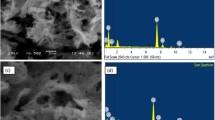Abstract
Arsenic contamination in groundwater is a severe global problem, most notably in Southeast Asia where millions suffer from acute and chronic arsenic poisoning. Removing arsenic from groundwater in impoverished rural or urban areas without electricity and with no manufacturing infrastructure remains a significant challenge. Magnetite nanocrystals have proven to be useful in arsenic remediation and could feasibly be synthesized by a thermal decomposition method that employs refluxing of FeOOH and oleic acid in 1-octadecene in a laboratory setup. To reduce the initial cost of production, $US 2600/kg, and make this nanomaterial widely available, we suggest that inexpensive and accessible “everyday” chemicals be used. Here we show that it is possible to create functional and high-quality nanocrystals using methods appropriate for manufacturing in diverse and minimal infrastructure, even those without electricity. We suggest that the transfer of this knowledge is best achieved using an open source concept.






Similar content being viewed by others
References
Acharyya, S. K., Chakraborty, P., et al. (1999). Arsenic poisoning in the Ganges delta. Nature, 401(6753), 545.
Ahmed, M. F., Ahuja, S., et al. (2006). Epidemiology—Ensuring safe drinking water in Bangladesh. Science, 314(5806), 1687–1688.
Al-Salim, N., Young, A. G., et al. (2007). Synthesis of CdSeS nanocrystals in coordinating and noncoordinating solvents: Solvent’s role in evolution of the optical and structural properties. Chemistry of Materials, 19(21), 5185–5193.
Asokan, S., Krueger, K. M., et al. (2005). The use of heat transfer fluids in the synthesis of high-quality CdSe quantum dots, core/shell quantum dots, and quantum rods. Nanotechnology, 16(10), 2000–2011.
Ball, P. (2005). Arsenic-free water still a pipedream. Nature, 436(7049), 313.
Bhattacharjee, Y. (2007). Toxicology—A sluggish response to humanity’s biggest mass poisoning. Science, 315(5819), 1659–1661.
Chakraborty, A. K., & Saha, K. C. (1987). Arsenical dermatosis from tubewell water in West-Bengal. Indian Journal of Medical Research, 85, 326–334.
Gan, H. L., Man, Y. B. C., et al. (2005). Characterisation of vegetable oils by surface acoustic wave sensing electronic nose. Food Chemistry, 89(4), 507–518.
Harvey, C. F., Swartz, C. H., et al. (2002). Arsenic mobility and groundwater extraction in Bangladesh. Science, 298(5598), 1602–1606.
Hossain, M. A., Sengupta, M. K., et al. (2005). Ineffectiveness and poor reliability of arsenic removal plants in West Bengal, India. Environmental Science and Technology, 39(11), 4300–4306.
Jain, C. K., & Ali, I. (2000). Arsenic: Occurrence, toxicity and speciation techniques. Water Research, 34(17), 4304–4312.
Jana, N. R., Chen, Y. F., et al. (2004). Size- and shape-controlled magnetic (Cr, Mn, Fe, Co, Ni) oxide nanocrystals via a simple and general approach. Chemistry of Materials, 16(20), 3931–3935.
Kelty, C. (2008). Two bits: The cultural significance of free software. Durham, NC: Duke University Press.
Lounsbury, M., Kelty, C., et al. (2009). Toward Open Source Nano: Arsenic Removal and Alternative Models of Technology Transfer. Advances in the Study of Entrepreneurship, Innovation and Economic Growth, 19, 51–78. G. D. Libecap (ed). Bingley, UK: Emerald Group.
Mayo, J. T., Yavuz, C., et al. (2007). The effect of nanocrystalline magnetite size on arsenic removal. Science and Technology of Advanced Materials, 8(1–2), 71–75.
Misawa, T., Hashimot, K., et al. (1974). Mechanism of formation of iron-oxide and oxyhydroxides in aqueous-solutions at room-temperature. Corrosion Science, 14(2), 131–149.
Mohan, D., & Pittman, C. U. (2007). Arsenic removal from water/wastewater using adsorbents—A critical review. Journal of Hazardous Materials, 142(1–2), 1–53.
Nickson, R., McArthur, J., et al. (1998). Arsenic poisoning of Bangladesh groundwater. Nature, 395(6700), 338.
National Policy for Arsenic Mitigation (NPAM) (2004). Available at: http://www.sdnpbd.org/sdi/policy/doc/arsenic_policy.pdf. Accessed 14 July 2009
Park, J., An, K. J., et al. (2004). Ultra-large-scale syntheses of monodisperse nanocrystals. Nature Materials, 3(12), 891–895.
Roca, A. G., Morales, M. P., et al. (2006). Synthesis of monodispersed magnetite particles from different organometallic precursors. IEEE Transactions on Magnetics, 42(10), 3025–3029.
Sapra, S., Rogach, A. L., et al. (2006). Phosphine-free synthesis of monodisperse CdSe nanocrystals in olive oil. Journal of Materials Chemistry, 16(33), 3391–3395.
Shannon, M. A., Bohn, P. W., et al. (2008). Science and technology for water purification in the coming decades. Nature, 452(7185), 301–310.
Sun, S. H., & Zeng, H. (2002). Size-controlled synthesis of magnetite nanoparticies. Journal of the American Chemical Society, 124(28), 8204–8205.
Sun, S. H., Zeng, H., et al. (2004). Monodisperse MFe2O4 (M = Fe, Co, Mn) nanoparticles. Journal of the American Chemical Society, 126(1), 273–279.
Twidwell, L. G., McCloskey, J., et al. (1999). Technologies and potential technologies for removing arsenic from process and mine wastewater. Warrendale, PA: Warrendale.
Weber, S. (2004). The success of open source. Boston, MA: Harvard University Press.
Yavuz, C. T., Mayo, J. T., et al. (2006). Low-field magnetic separation of monodisperse Fe3O4 nanocrystals. Science, 314(5801), 964–967.
Yean, S., Cong, L., et al. (2005). “Effect of magnetite particle size on adsorption and desorption of arsenite and arsenate. Journal of Materials Research, 20(12), 3255–3264.
Yu, W. W., & Falkner J. C., et al. (2004). Synthesis of monodisperse iron oxide nanocrystals by thermal decomposition of iron carboxylate salts. Chemical Communications, (20), 2306–2307.
Acknowledgments
We thank NSF for its support of the Center for Biological and Environmental Nanotechnology (EEC-0647452). We also acknowledge with gratitude the Office of Naval Research (N00014-04-1-0003), and the U.S. Environmental Protection Agency Star Program (RD-83253601-0) for funding. C.T.Y. thanks the Robert A. Welch Foundation ©-1342) for a graduate fellowship. C.T.Y. would like to thank the organizers of the International Congress on Production of Safe Water, January 21-23, 2009, Izmir, Turkey for the invitation.
Author information
Authors and Affiliations
Corresponding author
Additional information
This work was selected as the #2 in “Top Five Nanotech Breakthrough of 2006” by Forbes magazine and among the “Six ideas that will change the world” by Esquire magazine in 2007.
Rights and permissions
About this article
Cite this article
Yavuz, C.T., Mayo, J.T., Suchecki, C. et al. Pollution magnet: nano-magnetite for arsenic removal from drinking water. Environ Geochem Health 32, 327–334 (2010). https://doi.org/10.1007/s10653-010-9293-y
Received:
Accepted:
Published:
Issue Date:
DOI: https://doi.org/10.1007/s10653-010-9293-y




